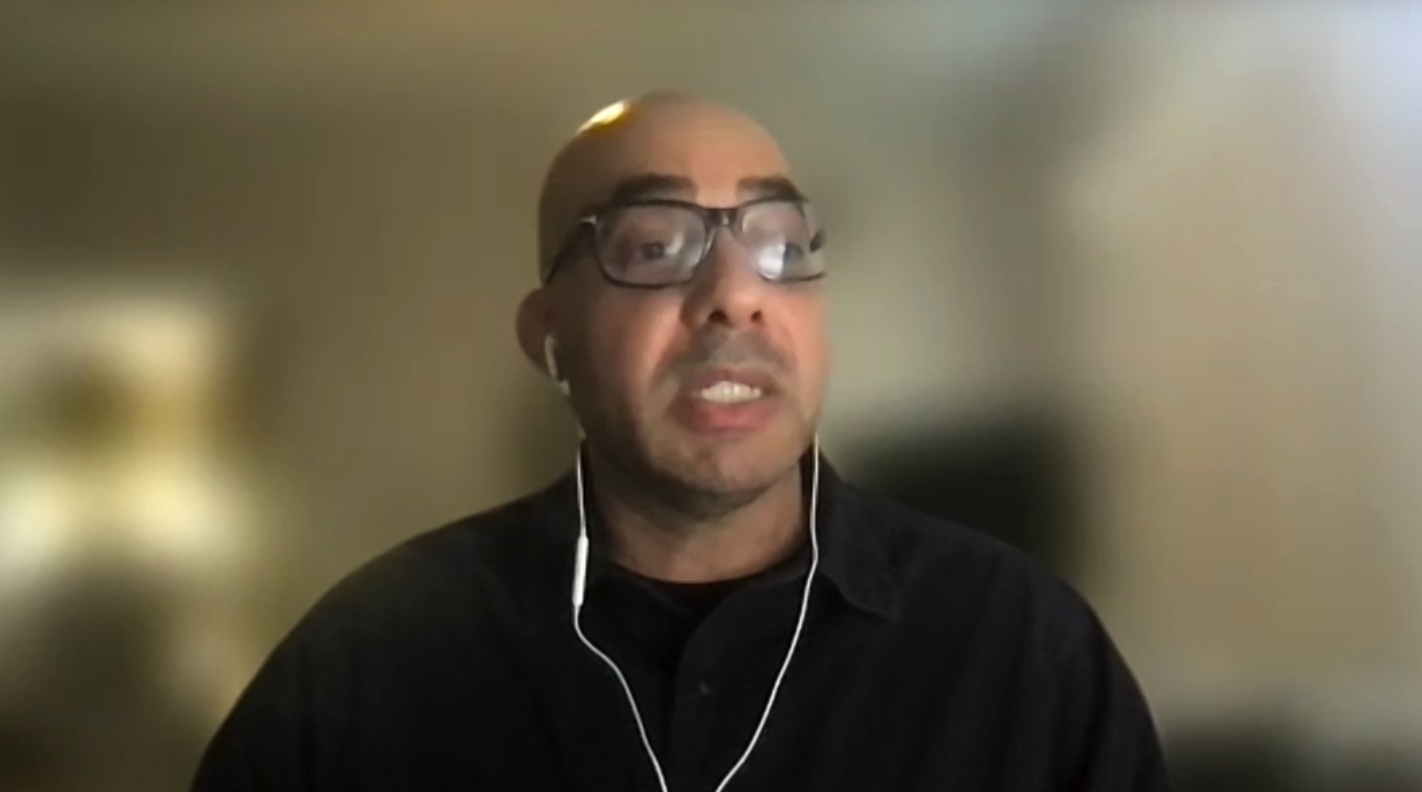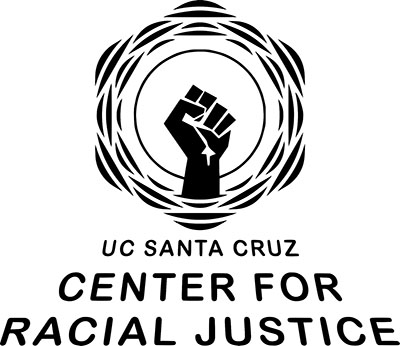The inaugural session of the Center for Racial Justice Summer Institute brought activists, community leaders, students, staff and faculty together in solidarity for racial justice

Yusef Omowale, a staff member of the Southern California Library, an archive that documents histories of community resistance to racism located in South Central L.A., guided the first day’s discussion.
This month, the Center For Racial Justice (CRJ) at UC Santa Cruz held its first-ever Summer Institute, “Political Education and Liberatory Knowledge,” complete with immersive, hands-on workshops that emphasized solidarity against systemic oppression and community-based strategies to fight anti-black racism and imperialism.
Each day of the inaugural CRJ Summer Institute featured teaching and collective study sessions, shared dialog, and workshops framed by different political educational approaches to racial justice, both past and present. The Summer Institute ran from August 10-12. These virtual events were free and open to the public. The attendance for the three days totaled 222 people.
UCSC associate professor of literature Christine Hong, chair of Critical Race and Ethnic Studies and director of the Center for Racial Justice, spoke about the potential for the workshop series to have far-ranging impact. Because they challenge the status quo, movements for racial justice have necessarily involved political education, Hong said. She pointed out that political education, for this reason, has taken place outside formal educational institutions during the history of racial justice movements.

Established in 2019 through seed funding from the university, the Center for Racial Justice (CRJ) aims to bring students, faculty, local communities, and invited guests together in much-needed campus-wide dialogue on race and racial justice.
“The Summer Institute presentations are not pitched narrowly to academics but have been organized to bring together community organizers, activists, teachers, students, and ethnic studies practitioners,” Hong said. Referring to the first day’s session, she said, “We hope that what will emerge here is a series of critical and clarifying discussions on solidarity against anti-blackness.”
The first day of the event, organized around the theme of “Practicing Solidarity Against Anti-Blackness in an Age of Reproduced Illusions,” drew 93 enthusiastic participants including local community activists as well as UCSC faculty, students, and staff. Those who attended came away with new inspiration as well as strategies for combating racism by considering its systemic causes.
Yusef Omowale, a staff member of the Southern California Library, an archive that documents histories of community resistance to racism located in South Central L.A., guided the first day’s discussion. Omowale broke the audience into working groups. Although each group was assigned a set of materials to review and discuss, the overarching emphasis was on structural context, history, and critical understanding as the basis of anti-racist solidarity.
Omowale’s connection to the Southern California Library provided rich historical context for his discussion, with its documentation of movements in L.A. and beyond that have challenged racism over the past 50 years. Every aspect of the group discussions was steeped in the history and culture of struggles against racism, starting with the screening of live footage of singer Nina Simone in 1968 performing “Don’t Let Me Be Misunderstood,” a song that was written for Simone and later turned into a hit by the British Invasion rock group The Animals.
Simone used her songs to fight racism and contribute her voice to the Civil Rights movement. Omowale opened with Simone’s performance of this song to illustrate how groups that experience racism often face misrepresentation, becoming the focus of media narratives that worsen their struggles.
As an example, he showed a documentary clip about the police shooting that killed Fred Hampton and Mark Clark of the Black Panther Party’s Chicago chapter in 1969. After Hampton’s and Clark’s assassinations, the police made false claims – amplified by sympathetic media – that they shot Hampton and Clark only after they were subject to a barrage of shooting from Black Panther Party members. But later ballistics reports showed that police fired all but one of the gunshots.
The community backlash against the official police account speaks to the ways in which Black people have contested dominant racist misrepresentations, Omowale said.
Although the Black Panther Party was initially held responsible for the shootout and even for the deaths of its own members, they had control over the apartment where the shootings took place, and gave community tours. In this way, they were able to show the public the circumstances of the killings, presenting evidence that contradicted the official story, correcting history in the process, Omowale said.
Much of the first day’s session centered on the aftermath and media coverage of violence that broke out in 2018 at the now-closed Happy Red Apple Nails salon in the Bronx. A viral surveillance video showed Asian workers attacking a group of Black women customers, one of whom had complained about the quality of a five-dollar eyebrow wax job. The fight increased neighborhood tensions and led to widespread protests.
Participants in the various working groups expressed strong sympathy for the Black customers who were beaten and forcibly prevented from leaving the business. Attendee comments initially focused on the spectacle of interethnic violence— “unlawful detention,” “heightened escalation,” “money and capitalism over people,” and “internalization of anti-Black racism”—and moved toward structural analysis, with mention of racial triangulation and shared sources of oppression.
Working group members also called attention to a Black man at the salon who was trying to position himself between both groups and ease the tensions. The video has no sound, but it is clear from his body language, and the way that others were reacting to him, that he was attempting to mediate and encourage non-violent responses to an escalating situation.
Often, media coverage of such events can be inflammatory, causing the public to be quick to judge without considering historical context, such as the fact that both the workers and the Black residents of the neighborhood have immigrant roots and are vulnerable, Omowale said. He mentioned that many of those who patronized the clinic are immigrants or descendants of immigrants from the Caribbean.
The violence against the patrons was shocking, and the patrons deserved to be treated with respect and dignity, Omowale said. But he also added complexity to this picture by asking, “What does it mean when you go to work and are willing to fight over $5? What might your conditions be? There are all kinds of reasons in which we are placed in these conditions, including dispossession and racial capitalism.”
After showing news footage of some Black community leaders calling not just for the nail salon to be shut down but also for the nail salon workers to be deported, Omowale asked attendees to consider what being “in community” and in solidarity with Black people means and whether some forms of historical harm are co-constituted. In response, some Summer Institute participants noted that many nail salon workers put in long hours for extremely low pay, and referred to an oft-cited New York Times report showing rampant exploitation of the salon workers.
Shauntay Larkins, UCSC director of Student Achievement, was alarmed by the brutality but pointed to the less visible violence inherent in the confrontation. “It spoke to the issue of how $5 is no longer just $5,” she said, referring to the disputed bill. “So much more is at stake for both of these communities being subjected to similar kinds of economic violence.”
“It would take a very special mediator to bring the two groups together because the resentments are entrenched,” Larkins said. “There should be some kind of restorative reconciliation because there are really two communities that are suffering.”
Mark Gardner, director of academic and cocurricular programs at UCSC, also emphasized “creating restorative space to address the harm that was caused” to the patrons.
Betsy Yoon, a member of the New York City-based, grassroots community organization Nodutdol, also underscored the need to “reorient community response away from neoliberal, power-aligned responses to injustice” in order to enact meaningful solidarity.
The second day of the Summer Institute was organized around the writings and legacies of theorist Harry Chang, who led study groups, including the Racism Research Project, throughout the 1960s and 1970s. Chang’s ideas influenced critical race theory, critical race studies, and anti-imperialist community-based organizing yet he has seldom been recognized for his influence in those arenas.
Organized around Chang’s writings, the morning workshop was facilitated by Paul Liem, the chairperson of the Korea Policy Institute, and JT Takagi, the executive director of Third World Newsreel. Focused on the theory and organizing imprinted by Chang’s conceptualization of race and racism, the afternoon session featured Neil Gotanda, professor emeritus of Western State College of Law and co-founder of the Critical Race Theory Workshop in the late 1980s, Linda Burnham, former national research director at the National Domestic Workers Alliance and co-founder of the Women of Color Resource Center, and Bob Wing, founding editor of ColorLines and War Times/Tiempo de Guerras.
The first session of the final day of the CRJ Summer Institute represented the launch of the public syllabus project of the Ending the Korean War Teaching Collective, which fosters critical approaches to understanding the war that complicate the ways in which this topic is often taught in schools.
Featuring Juyeon Rhee, for over a decade the main organizer of the Korea Education and Exposure Programs (KEEP), which educates and sends Koreans from the diaspora to North and South Korea to take part in peace and social justice work, the closing session focused on the long legacy of anti-imperialist hakseup (“hak” or study, plus “seup” or practice) stretching back to the Japanese colonial era and informed by the long movement of the Korean people against U.S.-backed military dictators in South Korea.
The plan is to hold a Summer Institute every other year, Christine Hong said. The next Summer Institute will take place in the summer of 2024.
Original Link: https://news.ucsc.edu/2022/08/crj-inaugural-summer-institute-feature-dw.html